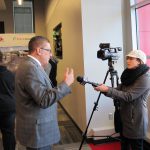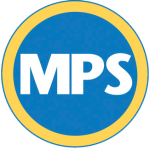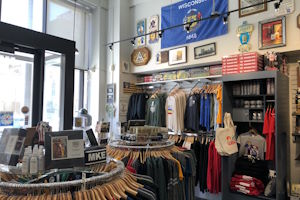2008-10 Vital Source Mag – October 2008
Visual Arts Picks
On Thursday, September 4, a video tribute dedicated to the victims of September 11, 2001 aired at the Republican National Convention in St. Paul. It prompted a visibly upset MSNBC commentator, Keith Olbermann, to apologize for its insensitivity. A week later, he was yanked as anchor for the November 4 election coverage. “Razor blades. Pocketknives. Scissors. Corkscrews. Nail clippers. Lighters. Match boxes. Innocent, everyday items, once routinely carried onto planes, took on different meanings after the events of September 11, 2001.” So reads a press release for Michele Pred: (dis) possessions, now through October 12 at the John Michael Kohler Arts Center in Sheboygan. Pred’s materials? Personal items (yours, mine) confiscated at airport security checkpoints. A California artist who exhibits globally, her “Fear Culture” features red, white and blue Petri dishes, each containing a seized object. Assembled to resemble an American flag, it challenges the core of American freedom – rather than preaching, it informs in a minimalist manner. It’s a good fit with the October 5 lecture in the Lubar Auditorium at MAM. Listen (for free) to “Monument Men” survivor Harry Ettlinger, who helped rescue artistic and cultural items plundered by the Nazis during World War II. Prints in MAM’s Gallery 13, titled The First World War: Its Horror and Its Aftermath, will prod you forward to November 4. On October 10, the 2007 Mary Nohl Fellowship Award event debuts at inova/Kenilworth. Photographer Kevin Miyazaki’s Camp Home series records the Tule Lake Japanese internment camp where his father and his family were placed during World War II. And on Gallery Night, October 17 the Milwaukee Institute of Art and Design’s Media Projects 2008 (curated by artist/ MIAD professor Jason S. Yi) includes the work of Bethany Springer, who explores place and its relationship to biology, terrorism, communication and security; at Dean Jensen Gallery, The Newspaper House unfolds. Peruse the newsy walls, inside and out, while considering the fragility of nature, and further, the fragility of life as the elections loom. Stop.look.listen: an exhibition of video works (from 14 global artists) starts October 23 at the Haggerty Museum of Art. Janet Biggs’ two-channel video installation (Predator and Prey, 2006) will air on huge plasma screens, similar to those displaying the 9-11 video at the Republican Convention. Images: past, present, and future. What is their role in shaping our perceptions in the year 2008 and beyond? VS
Oct 1st, 2008 by Stella CretekThe Sea and Cake
The latest album from Chicago’s The Sea and Cake finds the band mid-lap on the race begun on last year’s Everybody, in which the jazzy, poppy, light post-rock was more ebullient than the band’s debut material in 1993. The mid-lap shows whether the participants are capable of following through. The Sea and Cake have produced a fluid group of songs, most likely because these are their most quickly-penned compositions to date. Last year’s album had an effervescence it might not have claimed without the four years between it and 2003’s One Bedroom. That lifts the burden of the element of surprise from Car Alarm, which takes much of its attitude from the less-than-ayear-old Everybody. Sam Prekop – more Chet Baker than Stephen Malkmus – builds on the momentum of the previous release, which reached for the roots of Nassau-esque jazzy-pop and abandoned the more electronic leanings of One Bedroom. What the band had abandoned at that point is what makes Car Alarm kick in. A noticeable element of urgency gives a spark to opener “Aerial,” with driving drums and strong but fuzzy guitars making way for hints of electronic noodling. A driving tempo and smooth, steady instrumentation is tailored for natural electronic inclusions in the run of the album. This occurs in the oxygenated “CMS Sequence” – one minute and eight seconds of straight-up electronica, and a genre precursor to “Weekend,” which mixes the jazz-pop and electronic flavors nicely. Think of Everybody and Car Alarm as participants in a relay race consisting of two people: the strong and steady starter followed by a substantial and sparkling finisher.
Oct 1st, 2008 by Erin WolfOn Assignment
by Matt Wild + Photos by Kat Berger I’m sipping a flat rum and coke at a place called El Bait Shop (Spanish for: The Bait Shop) in downtown Des Moines, Iowa, when I realize how much this town is like a Lou Reed record: difficult, frustrating and haunted by past brilliance. Sure, there’s always something of worth to be found buried beneath the bright bars and non-existent music scene (or, in Lou Reed’s case, concept albums about Edgar Allen Poe) but damn if you don’t have to work for it. To explain: In late August, Vital sent me to cover the inaugural World Xtreme Boxing Challenge being held in Des Moines. Less than 48 hours before I was scheduled to leave, the tournament was cancelled. Figuring a weekend out of town might do me some good, I decided to make the trip anyway. My story would now be of the city itself, its similarities and differences to Milwaukee, its selling points and hidden treasures. It would also be a half-assed travelogue, one that would come to feature a failed Wayne Newton encounter, an appropriately geeky renaissance fair and me getting slapped in the face by a dwarf. And finally, like a Lou Reed album (I’m thinking something along the lines of Transformer now), it would be about how a road trip can be a bundle of blind hope, bitter disappointments and – given enough time and patience – something like a revelation. This is the story of that road trip. This is Des Moines. DAY 1 Looking out the windows of the ultra-swank Embassy Club atop the 801 Grand building, you can see nearly everything there is to see of Des Moines, a city roughly a quarter the size of Milwaukee. It’s a beautiful city, really, with the Iowa State Capitol – its 23-karat gold-plated dome shining in the sunset – overlooking downtown. I’m taking it all in with a glass of red wine in my hand, joined by Milwaukee’s own Amy Elliott, Bridget Brave and Kat Berger. (A quick note to male readers: when making a road trip with three women, it takes less than 20 minutes before the conversation turns to tampons and Judy Blume books.) We’ve just driven seven hours and have barely made our dinner appointment with three members of the Des Moines Convention and Visitors Bureau. There are no prices on our menus and the ladies look amazing. I’ve managed to put on a shirt and tie. The similarities between Des Moines and Milwaukee are striking: both share a clean, compact downtown that has benefited from recent revitalization programs, and both have a contentious, newly-erected bronze statue to contend with (in the case of Des Moines, it’s of recent Olympic gold-medalist Shawn Johnson). Other fun facts learned over our five-course meal: Des Moines is the insurance capital of America, it contains some of the most extensive urban biking/hiking trails in the world, and its four-mile downtown skywalk system is second-to-none. Later, a helpful Wikipedia […]
Oct 1st, 2008 by Matt Wild



















